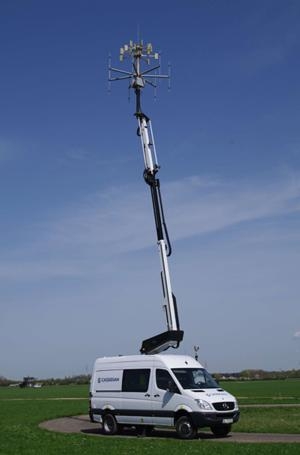Sun, May 11, 2014
UK Pursuing Technology To Improve Air Traffic Management
The Civil Aviation Authority (CAA), the UK's specialist aviation regulator, has awarded a study to Airbus Defense and Space to examine the feasibility of using the latest radar technology for better air traffic management.

Conventional radar uses a rotating antenna to sweep the sky, actively sending out radio pulses and detecting those which are reflected back from aircraft. Airbus Defense and Space has developed a so-called “passive radar” system that doesn't emit any radiation, but instead analyses radiation reflections from other emitters, such as radio and television stations, to detect objects. By measuring the differences between the original broadcast signal and the signals reflected from aircraft in the air, the position of the aircraft can be detected. The difference is that a passive radar system that relies on signals already in the air avoids creating additional emissions in populated areas, releases bandwidth for other uses and addresses the problem of misleading echoes from wind farms.
This type of new system potentially offers a highly cost effective and extremely reliable system. Passive radar is expected to be highly reliable as well as cost effective compared to the current systems in use in civil airports, because the current approach relies on one radar transmitter per airport putting enough signals in the sky. Translating the motto "Four eyes see more than two" into the radar world, several cost effective passive radar sensors using a number of emitters could broaden the basis for detection. The current active radars used can be susceptible to confusing echoes and interference from the increasing number of wind farms in the UK. Placing several passive radar sensors intelligently can eliminate these unwanted effects. Airbus Defense and Space announced in 2011 the development of a software and hardware radar modification to significantly mitigate interference from wind turbines.
Passive radar may also help to free up spectrum that could be used for an upcoming 5G network.
Airbus Defense and Space started to develop the passive radar solution in 2006 and has already demonstrated a working system, which can detect ultralight aircraft many miles away with accuracies down to 65 feet, as well as detect larger aircraft 135 miles away, making it one of the early pioneers and currently at the head of the field in this area. Airbus Defense and Space hopes that the application of this technology originally conceived for military use could reshape the way that air traffic is managed in the future.
(Image provided by Airbus)
More News
Also: SkyReach Parts Support, Piper Service Ctr, Airliner Near-Miss, Airshow London The Judge overseeing Icon's convoluted Chapter 11 process has approved $9 million in Chapter 11 >[...]
ILS PRM Approach An instrument landing system (ILS) approach conducted to parallel runways whose extended centerlines are separated by less than 4,300 feet and at least 3,000 feet >[...]
Aero Linx: FlyPups FlyPups transports dogs from desperate situations to fosters, no-kill shelters, and fur-ever homes. We deliver trained dogs to veterans for service and companion>[...]
Also: Skydio Chief, Uncle Sam Sues, Dash 7 magniX, OR UAS Accelerator US Secretary of the Air Force Frank Kendall was given a turn around the patch in the 'X-62A Variable In-flight>[...]
Also: NBAA on FAA Reauth, DJI AG Drones, HI Insurance Bill Defeated, SPSA Airtankers The Beechcraft Denali continues moving forward towards certification, having received its FAA T>[...]
 Airborne 05.10.24: Icon Auction, Drunk MedEvac Pilot, Bell ALFA
Airborne 05.10.24: Icon Auction, Drunk MedEvac Pilot, Bell ALFA ANN's Daily Aero-Term (05.13.24): ILS PRM Approach
ANN's Daily Aero-Term (05.13.24): ILS PRM Approach ANN's Daily Aero-Linx (05.13.24)
ANN's Daily Aero-Linx (05.13.24) Airborne-NextGen 05.07.24: AI-Piloted F-16, AgEagle, 1st 2 WorldView Sats
Airborne-NextGen 05.07.24: AI-Piloted F-16, AgEagle, 1st 2 WorldView Sats Airborne 05.08.24: Denali Update, Dad-Daughter Gyro, Lake SAIB
Airborne 05.08.24: Denali Update, Dad-Daughter Gyro, Lake SAIB



